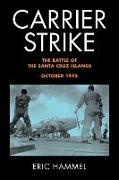Carrier Strike
BücherAngebote / Angebote:
CARRIER STRIKE
The Battle of the Santa Cruz Islands, October 1942
Eric Hammel
The Battle of the Santa Cruz Islands, a strategic naval action in the bitter Guadalcanal Campaign, was history's fourth carrier-versus-carrier naval battle. Though technically a Japanese victory, the battle proved to be Japan's last serious attempt to win the Pacific War by means of an all-out carrier confrontation. It was during the first four carrier battles-in the six-month period from early May through late October 1942-that the fate of Japan's small, elite naval air arm was sealed. It was at Coral Sea, in May, that Japan's juggernaut across the Pacific was blunted. It was at Midway, in June, that Japan's great carrier fleet was cut down to manageable size. And it was at Eastern Solomons, in August, and Santa Cruz, in October, that Japan's last best carrier air groups were ground to dust. After their technical victory at Santa Cruz, the Japanese withdrew their carriers from the South Pacific-and were never able to use them again as a strategically decisive weapon. Of the four Japanese aircraft carriers that participated in the Santa Cruz battle, only one survived the war. The Japanese "victory" at Santa Cruz cost Japan her last best hope to win the war in the Pacific. Once Japan's veteran carrier air groups had been shredded at off Guadalcanal, at Eastern Solomons and Santa Cruz, Japanese carriers ceased to be a strategic weapon.
Carrier Strike is the definitive history of the Battle of the Santa Cruz Islands.
Following Santa Cruz and the subsequent series of air and surface engagements known as the Naval Battle of Guadalcanal, the Imperial Navy's Combined Fleet never again attempted a meaningful strategic showdown with the U.S. Pacific Fleet. Though several subsequent surface actions in the Solomons were clearly Japanese victories, their results were short-lived. After November 1942, Japan could not again muster the staying power-or the willpower-to wage a strategic war with her navy. The Santa Cruz clash was deemed a Japanese victory because U.S. naval forces withdrew from the battlefield. That is how victory and defeat are strictly determined. But on the broader, strategic, level, the U.S. Navy won at Santa Cruz-because it was able to achieve its strategic goal of holding the line and buying time. Japan was unable to achieve her strategic goal of defeating the U.S. Pacific Fleet in a final, decisive, all-or-nothing battle. The technical victory cost Japan any serious hope she had of winning the Pacific naval war.
Folgt in ca. 15 Arbeitstagen




